This wonderful Cornish workshop and museum is dedicated to the legacy of studio pottery trailblazer Bernard Leach
Ripe for discussion: the obsession with fruit in art
Ripe for discussion: the obsession with fruit in art
31 May 2022
Artists have long used fruits as powerful symbols, from Ancient Egypt to present-day Hackney, says Chloë Ashby
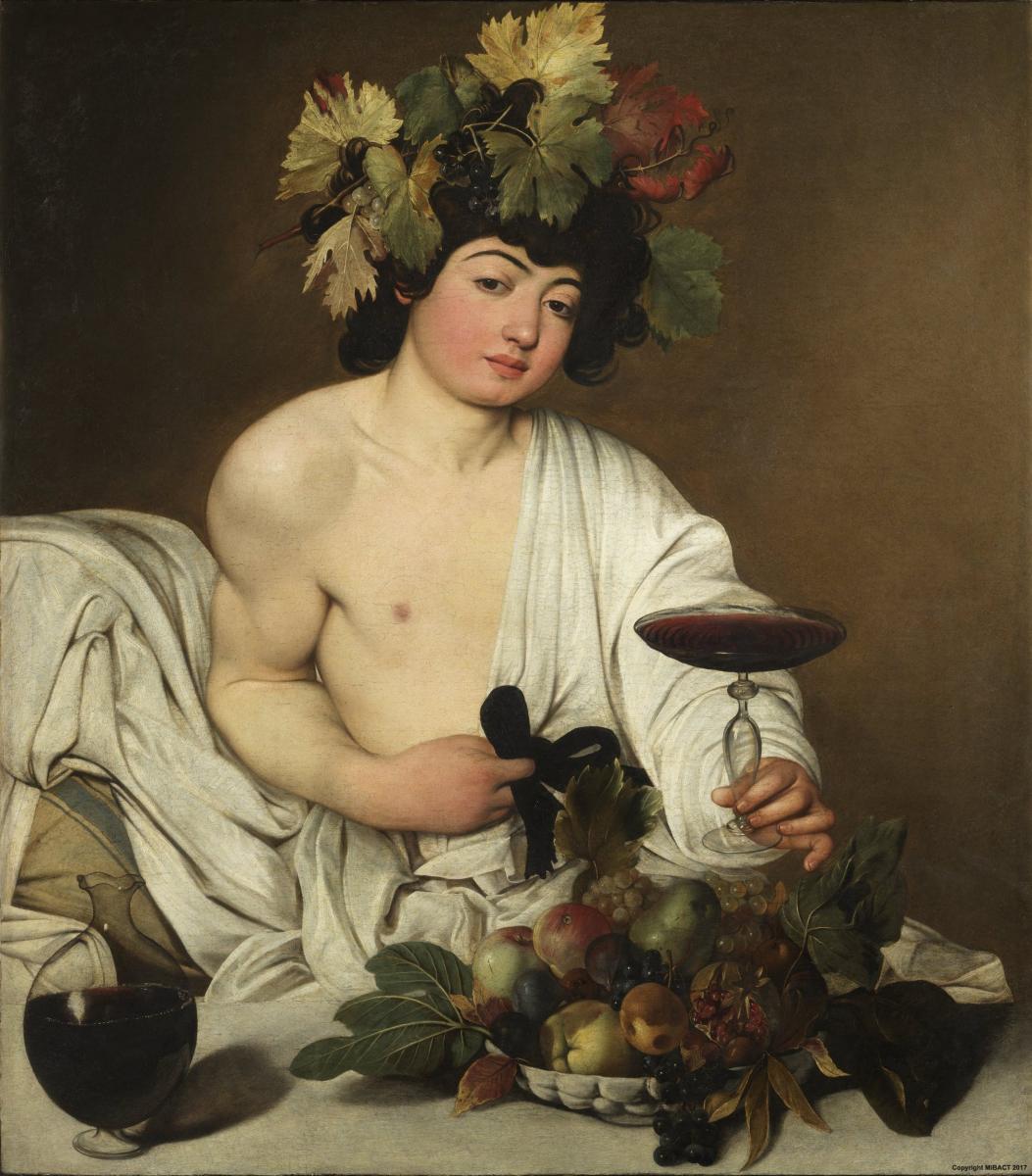
Caravaggio, Bacchus, c.1598
A young boy with heightened eyebrows and rosy cheeks props himself up on one elbow and offers us a shallow glass of red wine. His creamy robe covers only half of his chest, and with his free hand he fiddles with a velvety black bow. On the counter before him is a woven basket filled with dusky plums, rotting apples and a pomegranate that has burst open to reveal its fleshy interior. The boy’s dark curly hair is crowned with wilting vines and purple and green grapes, glistening like marbles in the light.
Caravaggio’s Bacchus (c.1598) is one of countless works in the history of art to indulge in the rich and varied symbolism of fruit. The tradition stretches back to the Romans, who ascribed fruits to their gods and goddesses, and ancient Egypt, where fruit was believed to await the dead in the afterlife and therefore depicted in tombs.
During the Middle Ages and the Renaissance, it became a visual language with which to delight, counsel and stun viewers: pears stood for fidelity, lemons deception, figs a fall from grace. Fruit has been known to evoke the seasons, the senses, even allegories. It contains moral and social messages – in Bacchus’s case, about youth and beauty (not to mention sensuality) and their inevitable decay.
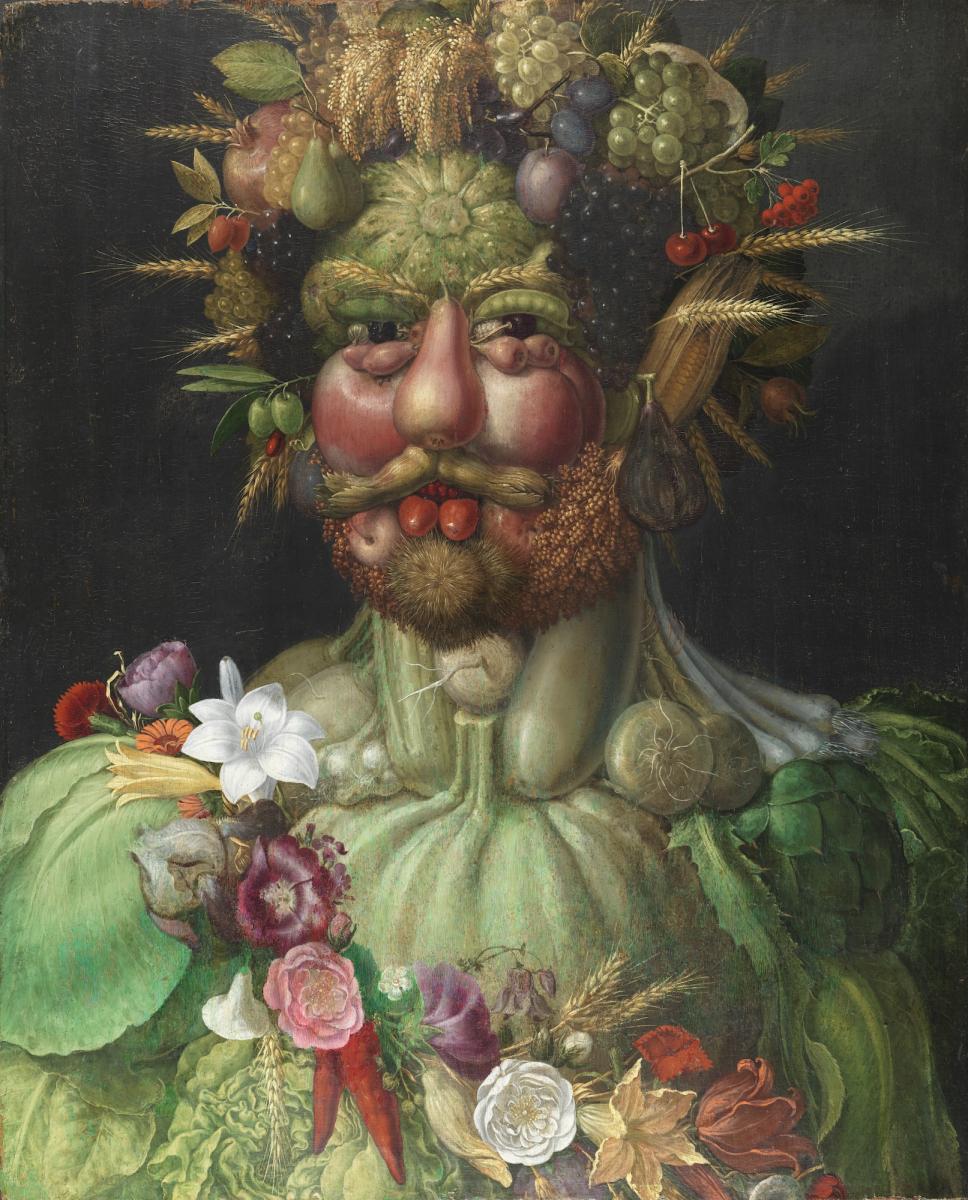
Giuseppe Arcimboldo, Vertumnus, 1591
While for some artists fruit has been a prop – a small still life within a larger, more elaborate scene – for others it has been the main event. Think Giuseppe Arcimboldo’s fruit-faced portraits, René Magritte’s hovering green apple and Hollis Frampton’s voluptuous video work Lemon (1969). In recent years, contemporary sculptors have been using fruit to challenge the status quo and renegotiate with the past. Zoe Leonard’s Strange Fruit (1992–97), a series of fruit skins that have been emptied, dried and carefully repaired with thread, is a relic-like reminder of the AIDS crisis. Maurizio Cattelan’s Comedian (2019), a banana duct-taped to a wall, which sold for $120,000 at Art Basel in Miami, pokes fun at the absurdity of the art market.
The Los Angeles-born, New York-based artist Kathleen Ryan uses fruit to challenge notions of desire, value and excess. Her signature oversized lemons are heavily embellished with glass beads and semi-precious stones. The yellow parts comprise only glass beads, while the patches that look mouldy are populated with luxurious natural materials, from coral beads to freshwater pearls. While the fruit is rotting, the mould is thriving. Tied up with it all are notions of mortality.
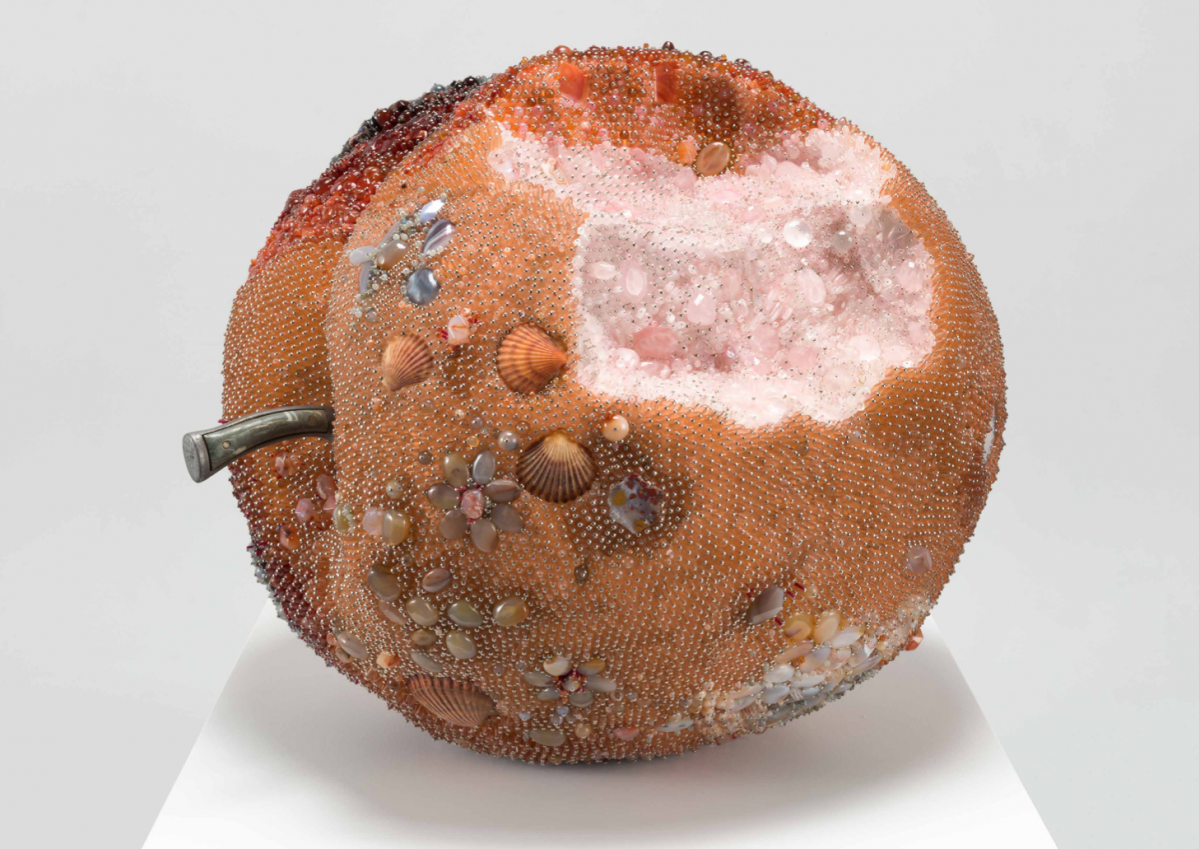
Kathleen Ryan, Bad Peach (Bite), 2022. Courtesy the artist and Josh Lilley
The edible artwork that fellow New York-based artist Darren Bader installed in the Whitney Museum of American Art in 2020 calls into question not only what art is, but also the way in which museums collect and display it. The untitled work comprises a cornucopia of fresh fruits and vegetables, each variety presented on a wooden plinth.
During the exhibition, museum staff collected the ripened items four times a week and – according to Bader’s instructions – made a salad which was served to viewers. The plinths were then replenished, and the process continued, stimulating thoughts about the relationship between art and consumer, as well as the consumption of food and entertainment.
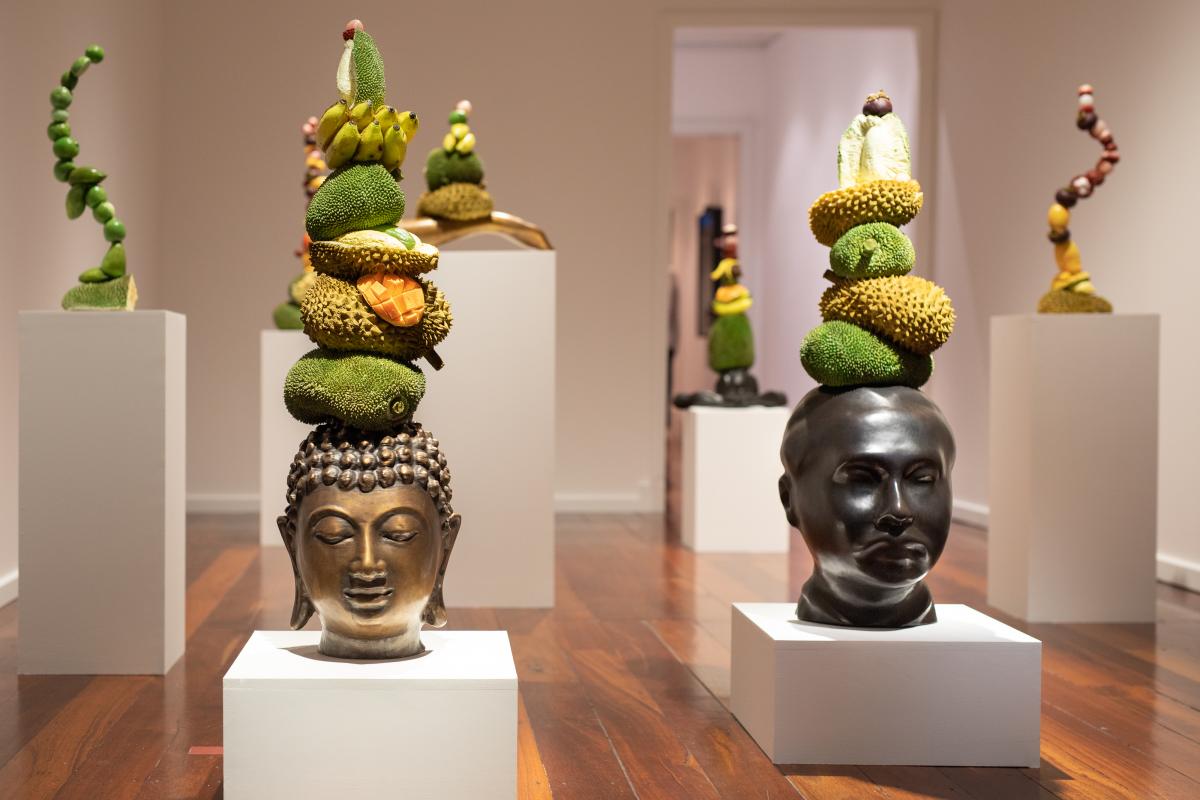
Nathan Beard, installation view of Low Yield Fruit, photo Emma Dolzadelli courtesy of the Minderoo Foundation
The fruit totems of multidisciplinary artist Nathan Beard are a little longer lasting. Silicone casts of durians, mangos, jackfruit and other pieces of fruit exported from Thailand to Australia are spiked on bronze forms that resemble the limbs and heads of statues found in Buddhist shrines. Piled high and jumbled with limes from the artist’s late mother’s garden, the body of work, known as Low Yield Fruit, considers ideas of economy, exoticism and ‘acquired taste’.
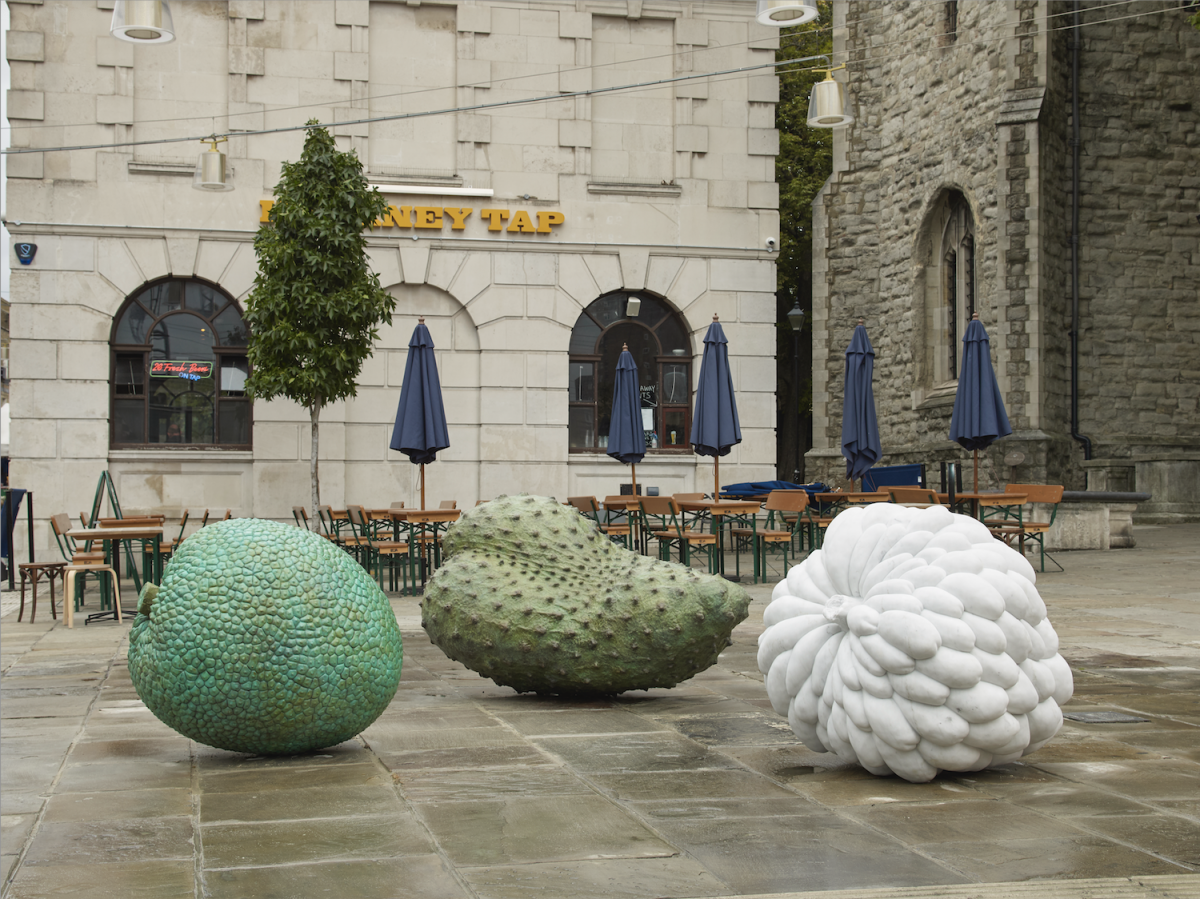
Veronica Ryan OBE, Custard Apple (Annonaceae), Breadfruit (Moraceae), and Soursop (Annonaceae), 2021. Courtesy the artist, Paula Cooper Gallery and Alison Jacques. Photo: Andy Keate, 2021
Cultural memory is at the heart of Veronica Ryan’s Turner Prize-nominated fruit sculptures in the east London borough of Hackney. The Montserrat-born British sculptor was invited to make the UK’s first permanent monument to the Windrush generation, and she responded with three patinated bronze and marble sculptures of giant Caribbean fruits: Custard Apple (Annonaceae), Breadfruit (Moraceae) and Soursop (Annonaceae).
As a child, Ryan visited the nearby Ridley Road Market with her mother, and she remembers discovering tropical fruits and vegetables associated with the Caribbean. With this work, located on the busy corner of Mare Street, she celebrates the cultural heritage of the local diaspora community, and their lush contribution to British life.
Life and death, love and sexuality, growth and decay: fruit’s associations are endless. Like all foodstuffs, it’s something that contains memories and brings people together. So, the next time you’re gazing at an artwork, and you spot a waxy lemon or a glistening clementine or a pointed pineapple, pause for a while, and consider what it might mean. Fruit is good for you, yes, but it also speaks to our very existence.
About the Author
Chloë Ashby
Chloë Ashby is a writer and author of Wet Paint, out now
JOIN OUR MAILING LIST
Become an instant expert!
Find out more about the arts by becoming a Supporter of The Arts Society.
For just £20 a year you will receive invitations to exclusive member events and courses, special offers and concessions, our regular newsletter and our beautiful arts magazine, full of news, views, events and artist profiles.
FIND YOUR NEAREST SOCIETY
MORE FEATURES
Ever wanted to write a crime novel? As Britain’s annual crime writing festival opens, we uncover some top leads
It’s just 10 days until the Summer Olympic Games open in Paris. To mark the moment, Simon Inglis reveals how art and design play a key part in this, the world’s most spectacular multi-sport competition



